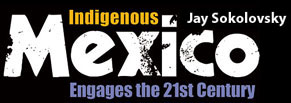Chapter 2. Orientation to This Book
Introduces students to the core constructs of cultural scripts, cultural spaces, ethnoscapes and globalization. This chapter demonstrates how they will be used to understand dramatic life course and community transformations over the past four decades.
Added Value: “Their Mexican Home Town”
In Amanalco, to date there has been only limited international migration. This contrasts with other Mexican regions, especially in the state of Puebla or Oaxaca where one might find equal numbers of villagers in Brooklyn, New York as you do in their Mexican home town (Smith 2005, Boehm 2013).
Added Value: Sustained research on Nahuatl communities.
Beginning in the late 1960s and 1970s, anthropologists including myself would undertake what was to become multi-decade research in Nahuatl speaking regions in Mexico. These include:
James Taggart in the mountains of northern Puebla
Nahuatl Ethnicity in a Time of Agrarian Conflict. In Frances F. Berdan, John K. Chance, Alan R. Sandstrom, James Taggart and Emily Umberger, eds., Ethnic Identity in Indigenous Mesoamerica: The View from Archaeology, Ethnohistory, and Contemporary Ethnography. 2008. Salt Lake City: University of Utah Press, pp. 183-203.
Alan Sandstrom on the coastal tropical forest of northern Veracruz:
Corn is Our Blood: Culture & Ethnic Identity in a Contemporary Aztec Indian Village, 1992. Norma, OK: University of Oklahoma Press.
Catherine Good in Guerrero’s Balsas River Basin
My Thirty Years in Mexican Anthropology. Anthropology and Humanism. 2011:Volume 36, Issue 1, pages 36–46.
David Robichaux and Francis Rothstein in Tlaxcala, just east of Amanalco:
David Robichaux
Familias Nahuas en la Edad Industrial: Cambios y Permanencias en la Estructura y Organización Domésticas en Tlaxcala. In David Robichaux, ed., Familia y Parentesco en México y Mesoamérica. Unas Miradas Antropológicas. 2005. México: Universidad Iberoamericana, pp. 117-150.
Francis Rothstein
Globalization in Rural Mexico: Three Decades of Change. 2007. Austin: University of Texas Press.
PowerPoint: Glimpses into a Globalized Future in 1978
Other kinds of inputs from global companies are epitomized in the photo below from 1978. Figure 2.1 shows an image of products in the small store off the central plaza where one found; Twinkies, Wonder Bread, baby formula, Bic pens, Alka Seltzer and a variety of soft drinks. Sodas such as Coca Cola became readily available and problematic for long-term health; due to less regulation they contained even more sugar content than similar products sold in the United States. This is but one reason why by the 1990s, diabetes began to rise in Amanalco and by 2010 it had become the most prevalent chronic disease in Mexico.
Figure 2.1 Central general store in Amanalco, 1978
In case you missed it click the on picture above here to direct you to the items mentioned above. Also you can click small box in right corner of picture to make it larger.© Jay Sokolovsky
Added Value: Transnational communities and gender
For an article on gender and a transnational community in Albuquerque, New Mexico see, “Gender(ed) Migrations: Shifting Gender Subjectivities in a Transnational Mexican Community”
